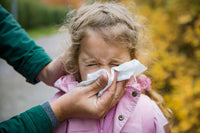By Kathryn Peck / Medically reviewed by Dr. Samantha Ball, DO
You know something is off these days when a parent breathes a sigh of relief and says, “Oh thank goodness, it’s just croup.” That was me a week or so ago.
Over the holidays, my two littlest ones passed a nasty, junky, barking cough back and forth. And these days, a COVID-19 diagnosis is always the biggest concern at the forefront of everyone’s mind. Well, after a visit to the doctor, it was confirmed: it’s just croup.
Croup always seemed like an old-fashioned word to me, something used a long time ago to describe a relatively unknown ailment. It’s like Lockjaw (aka tetanus), consumption (aka tuberculosis), or ague (aka fever) – those terms you don’t hear much anymore.
Croup always seemed like an old-fashioned word to me, something used a long time ago to describe a relatively unknown ailment.
But I didn’t realize until recently how wretched this sickness, even mild, is for little ones – and for the parents staying up all night with them. Relentless coughing until it hurts, breathing is difficult, fever – and everything becomes worse when your little one’s head hits the pillow.
Croup is a viral infection of the upper airways, a swelling and irritation around the voice box (larynx) and windpipe (trachea). And the swelling makes the passing of air when coughing difficult, hence the bark-like coughing and a child’s difficulty breathing at times.
You’ll often hear croup, bronchiolitis, bronchitis, and pneumonia all grouped together, but each one represents the location of the problem in the body: croup – voice box/larynx; bronchiolitis - the bronchioles or the smaller airways that stem from the main breathing tubes; bronchitis – the main breathing tubes; pneumonia – lungs.
When my son was gasping for air in between coughs, it was a huge red flag. This didn’t seem like a normal, common cold-type cough. And when I listened to him breathe closely, I could almost hear each wheezy breath.
And when I listened to him breathe closely, I could almost hear each wheezy breath.
My other son presented with a fever, but that’s another common symptom of croup. And in true form, croup worsens at night. It typically lasts 3-5 days, but for tired and worried parents, those 3-5 days seem like weeks.
They say that children between 6 months and 3 years of age are most at risk of getting croup because of their small airways, and they are therefore most disposed to having more symptoms with croup.
How can you prevent the spread of croup or getting it? Like most germs, simple measures like frequent hand-washing and coughing or sneezing into your arms are recommended.
If you’re questioning a child’s cough (especially during the Covid-19 pandemic), it’s best to see a doctor. A doctor will listen to your child’s breathing with a stethoscope and examine their throat. (X-rays may be required, but most likely not.)
Croup is largely treatable at home (and yes, keep your child home) with cool mist humidifiers or a cool air nebulizer, but if unavailable, steam from a hot shower is also recommended. Another trick is to put your face up to the freezer and breath in the cold air or, this time of year, simply step outside for some cold air. It was best explained to me this way: increased temperature causes the body to need more oxygen, like exercising. Anything that can make the respiratory system work less is better. Acetaminophen is also an option, particularly for those with a fever.
In our case, the doctor also gave my son a mild steroid (dexamethasone) to shorten the duration of the disease and ease the discomfort of his symptoms. He got to eat the applesauce, and I noticed an improvement almost immediately.
Statistics show that croup affects around 3% of children per year, so perhaps it isn’t as old-fashioned as one would think. Questions, concerns – always consult your doctor. It’s always better to know.
-
Please note: This is for educational and informational purposes only and is not meant to substitute individual medical advice. For specific and individual advice, always talk to your doctor.
About the author: Kathryn is the owner of Bicycle Pie and mom of 4 little ones. Also a writer, editor, and former owner of one of Boston's premiere baby boutiques, she continues to write about motherhood, children's products, family life, and all other things that test our skills and patience as parents.
About the reviewer: Dr. Samantha Ball, DO, is a pediatrician, cat mom, and advocate for children’s overall health and wellness. She is continually focused on supporting families through all stages in a realistic and evidence-based way. In addition to practicing medicine in Georgia, she shares experiences and her perspectives on topics including parenting tips, mental and physical health, and how to navigate the unexpected challenges that come about when raising kids.
Photo credit: iStock.com/ozgurdonmaz




